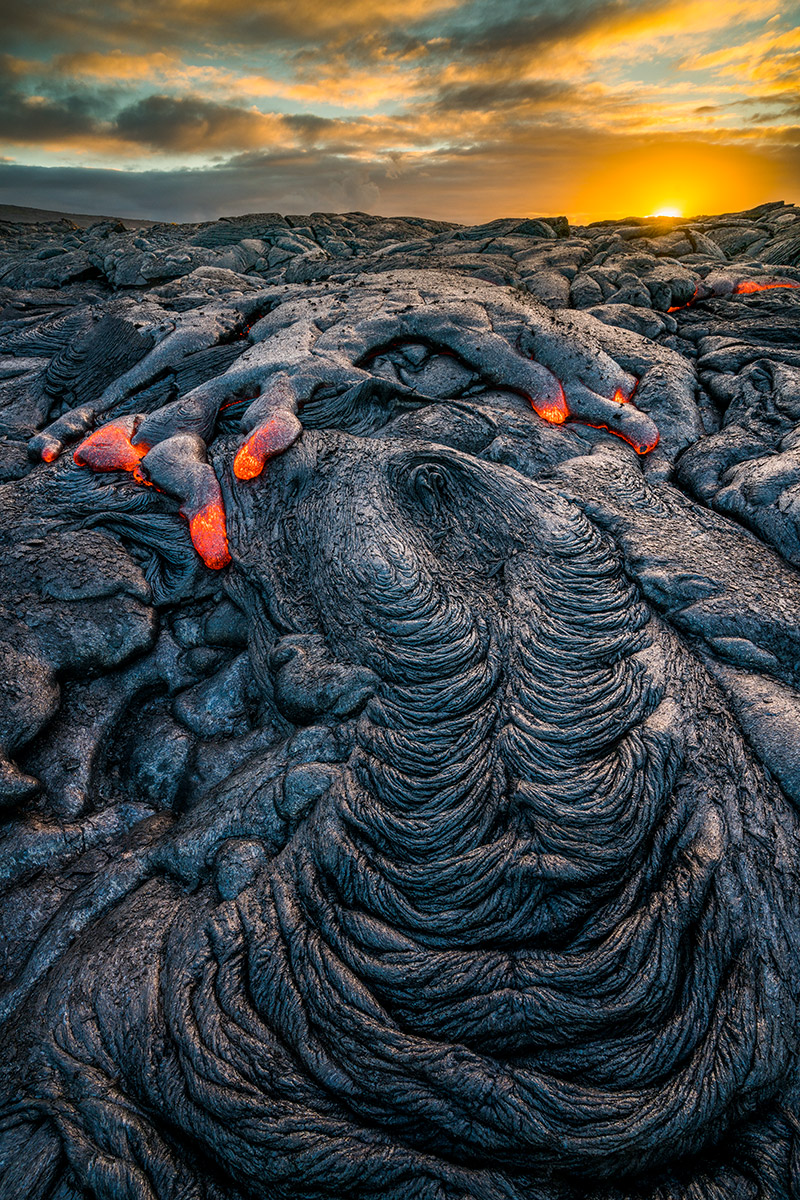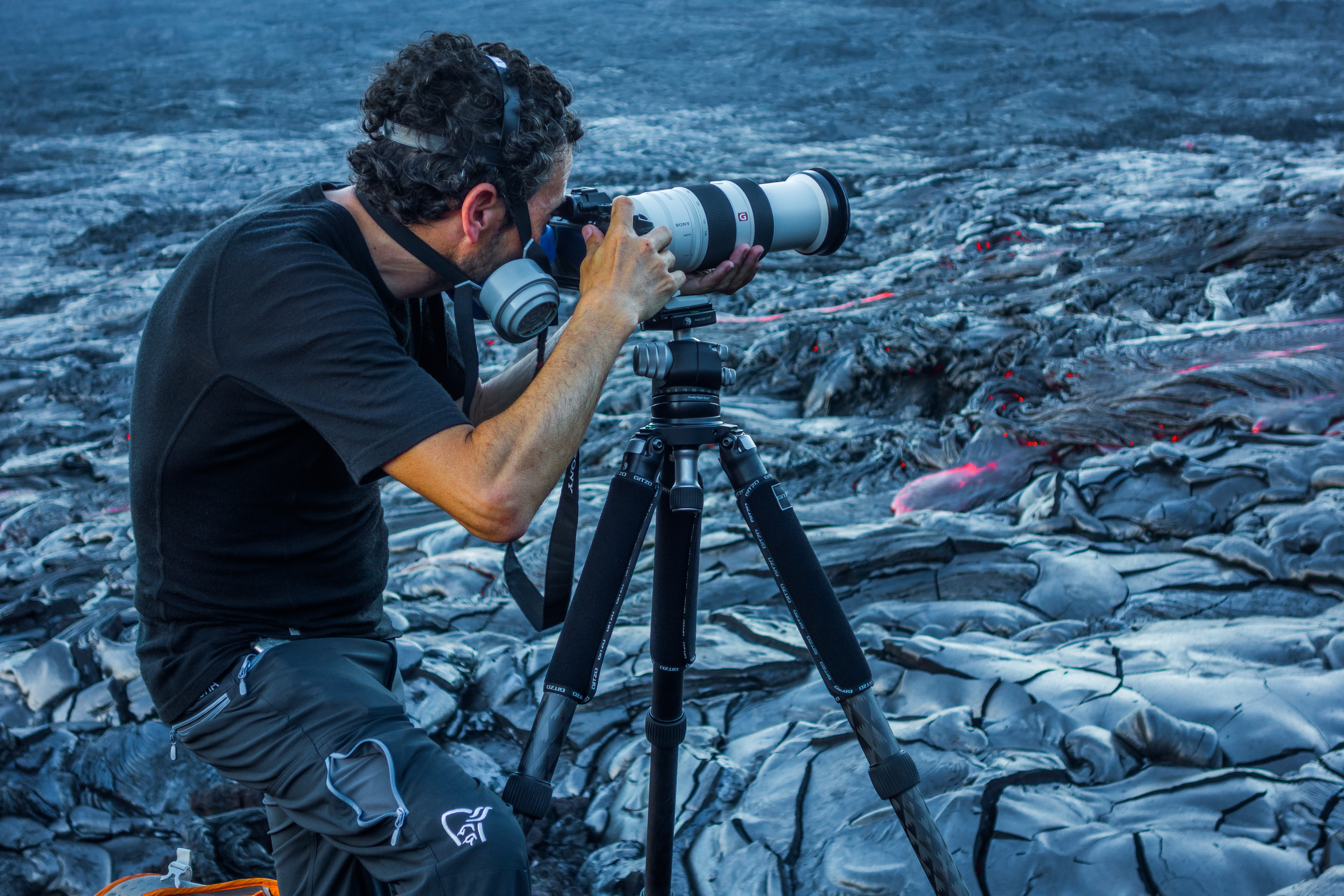
En español más abajo.
The soles of my trekking shoes were completely smooth after the more than 200 km we walked through the lava fields of Hawaii’s Big Island Volcano Park for 18 days. The volcanic glass acts like thin blades that literally eat up the rubber drawings. It is so sharp that it is recommended to walk with your legs protected and always wear gloves, if you want to avoid injuries when rubbing or supporting yourself.
But walking through the lava fields is an incredible experience. Sometimes the ground is so hot that it burns. Then you know that the lava is very close to the surface and that most likely there is a tube underneath through which the rock flows. Then you put yourself on alert. You know there may be some nearby outcrop and you don’t want to step where you don’t belong.
The smell of burnt rock floods everything. There are areas where there are fumes of gases, which include carbon dioxide, sulfur dioxide, hydrogen sulfide, and hydrogen halides. Depending on the concentration, they can cause irritation of the respiratory tract, skin, eyes and mucous membranes. The danger increases when water interacts with lava. This was the combination that led to a fatal outcome for photographer Sean King in February 2018. While guiding a group of tourists in the Kalapana moors, he was surprised by a torrential rain, the cloud of toxic gases that was produced prevented him from escaping the area and killed him. It is therefore essential to protect yourself with a good mask, which keeps the air breathable in the presence of toxic gases, although this does not prevent the need to take extreme precautions.
The sun had not yet risen when I found this area surrounded by several nearby lava sources. I was forced to move constantly with my tripod, because the landscape literally changed before my eyes in a matter of minutes. The sun was about to loom over the horizon and I knew that in these latitudes the sunrise and its magical light would only last a few minutes, so I was aware that I was not going to have second chances.
The incandescent rock began to spill slowly resembling the pseudopods of an amoeba on a wash that had frozen for eternity in twisted textures, like the Hellenic heroes who were petrified by the gaze of Medusa. At that moment the Sun appeared on the horizon among the clouds that flew over the Pacific. The scene reminded me of those sterile planets illuminated by a distant star, the exotic setting of the science fiction novels of my childhood.
This image has been recognized with the runner-up in the landscape category of the Nature Photographer of the Year 2019.

Las suelas de mis zapatos de trekking quedaron completamente lisas después de los más de 200 km que caminamos a través de los campos de lava del Parque de los Volcanes de la Big Island de Hawaii durante 18 días. El vidrio volcánico actúa como finas cuchillas que se van comiendo literalmente los dibujos de goma. Es tan cortante que se recomienda caminar con las piernas protegidas y llevar siempre guantes, si quieres evitar heridas al rozarte o apoyarte.
Pero caminar por los campos de lava es una experiencia increíble. Hay veces que el suelo está tan caliente que quema. Entonces sabes que la lava está muy cerca de la superficie y que lo más probable es que debajo haya un tubo por el que fluye la roca. Entonces te pones en alerta. Sabes que puede haber algún afloramiento cercano y no quieres pisar donde no debes.
El olor a roca quemada lo inunda todo. Hay áreas en las que hay emanaciones de gases, que incluyen dióxido de carbono, dióxido de azufre, sulfuro de hidrógeno y halogenuros de hidrógeno. Dependiendo de la concentración, pueden producir irritaciones de las vías respiratorias, piel, ojos y mucosas. El peligro aumenta cuando el agua interacciona con la lava. Esta fue la combinación que llevó a un desenlace fatal al fotógrafo Sean King en febrero del 2018. Mientras guiaba a un grupo de turistas en los páramos de Kalapana, fue sorprendido por una lluvia torrencial, la nube de gases tóxicos que se produjo le impidió escapar de la zona y acabó con su vida. Por ello es imprescindible protegerse con una buena máscara, que mantenga el aire respirable en presencia de gases tóxicos, aunque eso no evita que sea necesario extremar las precauciones.
El sol todavía no había salido cuando encontré esta zona rodeada por varias fuentes de lava cercanas. Me veía obligado moverme constantemente con mi trípode, porque el paisaje cambiaba literalmente ante mis ojos en cuestión de minutos. El sol estaba a punto de asomar por el horizonte y sabía que en estas latitudes el amanecer y su mágica luz duraría solo unos minutos, así que era consciente de que no iba a tener segundas oportunidades.
La roca incandescente comenzó a derramarse lentamente asemejando los pseudópodos de una ameba sobre una colada que se había congelado para la eternidad en retorcidas texturas, como los héroes helénicos que caían petrificados por la mirada de Medusa. En ese momento el Sol asomó por el horizonte entre las nubes que sobrevolaban el Pacífico. La escena me recordaba a aquellos planetas estériles iluminados por una estrella lejana, el exótico escenario de las novelas de ciencia ficción de mi infancia.
Esta imagen ha sido reconocida con el runner-up en la categoría de paisajes del Nature Photographer of the Year del 2019.